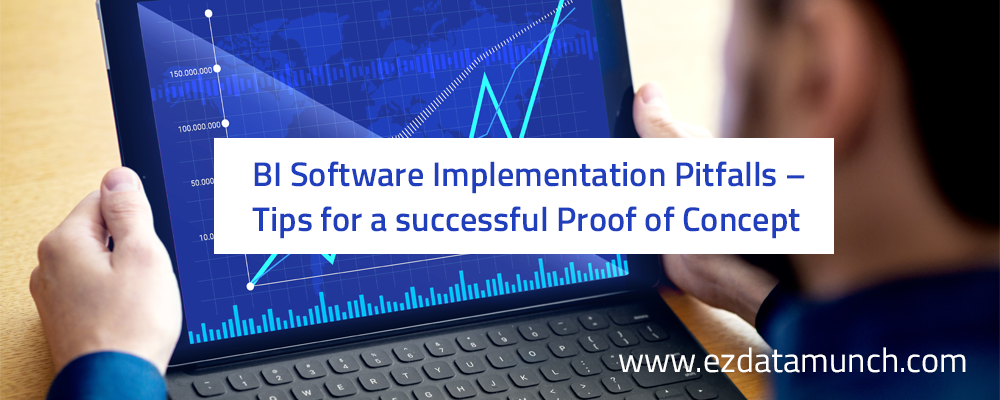(In my previous blog I highlighted few points regarding factors to examine before deciding on a BI solution. Please click the link to read it in case you missed it)
Part #2 Tips for a Successful Proof of Concept:

Tips for a successful POC
- Address future requirements as well as current ones.
- Consult with your own IT professionals.
- Refuse to invest a lot of money in a POC.
- Focus on BI dashboard capabilities –don’t get distracted by pretty visuals.
Address Current & Future Requirements:

Most BI vendors insist that you predefine your requirements in order to have a successful project or POC. The problem is, it’s almost impossible to know your future requirements in advance.
BI requirements are highly dynamic as businesses are constantly changing, and business users always need to refine and adjust their requirements. Today’s analysis is only relevant for a short period of time before becoming obsolete.
Bottom line: Focus the POC on the ability to meet ad-hoc requirements, not just a set of fixed reports that may be irrelevant by the time the BI implementation project ends.
Consult with Your Own IT Professionals

Business professionals that are frustrated by not being able to extract relevant data quickly and independently will often look for a BI solution that cuts IT completely out of the loop.
Though you should look for a BI solution that requires minimal IT involvement. It is still highly recommended to consult your IT professionals about technical topics, such as scalability, integration cycles and so forth.
Bottom line: The vendor has no interest in sharing the technicalities that make their BI solution more complicated, and these are some of the issues that can trip up the success of any project.
Refuse to Invest a Lot of Money in a POC

Some BI vendors promise you the world, but demand significant upfront investment to prepare the projects, hardware and software for a POC –all before you even run one report on your actual data.
Don’t agree to this. Demand to have at least one solid BI report or BI dashboard running over your own data before you agree to any financial commitment.
Bottom line: If a BI vendor is not willing to work with you before you put money down, it’s probably because they’d have to spend weeks on development before delivering anything. Meaning, this vendor is either selling archaic technology or is misleading you about the capabilities of their Business Intelligence tools.
Focus on Capabilities-Don’t Get Distracted by Pretty Visuals

The biggest mistake buyers make is to judge a BI vendor based on their shiny and pretty BI dashboard samples. Visualization software components are a dime a dozen.
The real challenge is easily creating and customizing BI dashboards that show your own data –no matter how big your data is, and even when it’s scattered across multiple data sources.
Bottom line: If a BI vendor can’t get your own data to display in dynamic and creative ways within just a few days, you should probably find a better one.
How to avoid the pitfalls?

Here’s the best piece of advice: Always ask for a proof of concept (POC) that connects to your real data sources.
FAQ’s
What common challenges do organizations face when implementing BI software?
Organizations often struggle with data quality issues, integration complexities, user adoption hurdles, and aligning business objectives with technical capabilities. Additionally, inadequate planning, lack of stakeholder buy-in, and underestimating resource requirements are common challenges.
How can a proof-of-concept help mitigate risks during BI software implementation?
A proof of concept allows organizations to evaluate the BI software’s capabilities in a controlled environment before committing to full-scale deployment. It helps identify potential pitfalls early on, validates the solution’s suitability for specific business needs, and provides insights into implementation challenges and requirements.
What are some key factors to consider when planning a proof of concept for BI software?
It’s essential to define clear objectives, success criteria, and scope for the proof of concept. Identify relevant use cases that demonstrate the software’s capabilities and align with organizational goals. Ensure access to representative data sets and involve stakeholders from different departments to gather diverse perspectives.
How can organizations ensure successful user adoption of BI software following a proof of concept?
User involvement and feedback during the proof-of-concept stage are crucial for driving adoption. Engage end-users early in the process to understand their needs and preferences. Provide adequate training and support resources to empower users to leverage the BI software effectively. Additionally, communicate the benefits and value proposition of the software to foster enthusiasm among users.
What are some warning signs that indicate a proof of concept for BI software may not be successful?
Delays in achieving milestones, persistent technical issues, and lack of alignment between expected outcomes and observed results are red flags that warrant attention. Resistance from stakeholders or users, insufficient support from the vendor, and escalating costs beyond initial estimates are also indicators of potential challenges. Regular monitoring and open communication can help address issues proactively.

Milan Desai as a Chief Technology Officer has more than 20 years of industry experience in working with clients to solve business problems. Passionate about leveraging technology for improving the quality of life and optimize the use of resources. Currently, working on utilizing data to drive business decision making process and user understanding of key metrics that drive the organization and markets in general. Chief Technology Officer of EzDataMunch – the first BI Apps store in the world.

